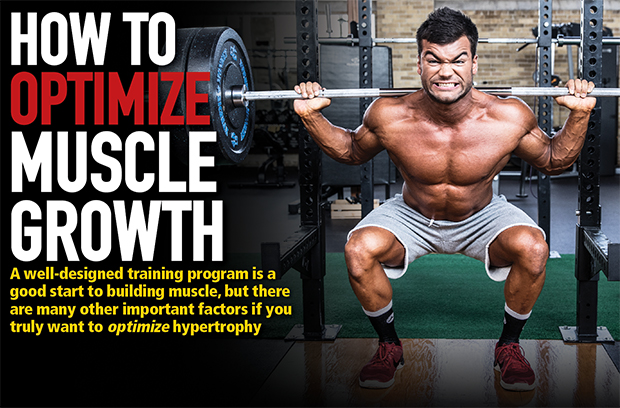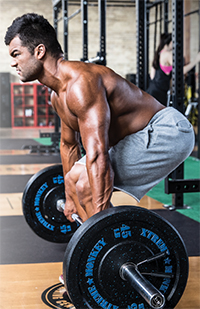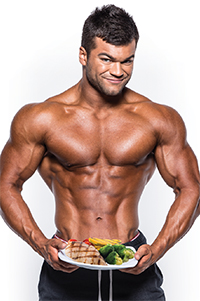Best Beginners’ Program: How to Optimize Muscle Growth

A well-designed training program is a good start to building muscle, but there are many other important factors if you truly want to optimize hypertrophy
Some folks approach building muscle like a blind man, simply walking into a gym and just randomly doing exercises and following what other guys do—including copying their bad form. That approach will probably do something.
Others take an all-inclusive approach, gathering information on how the various components of diet, recovery, training, sleep, and smart supplementation work together to optimize results. Acing just one aspect without paying attention to the others is a sure way to sabotage your gains, and you’ll likely soon quit as a result.
Understanding how the pie fits together is an important step in ensuring you’re getting the most from all your efforts. Realize that these are the most important concepts of muscle building that you’ll constantly revisit over the years, and eventually you’ll learn how to manipulate and tinker with the various components as you progress.
This is the framework for building max muscle, so let’s get to it.
1. Build Your Training to Optimize Results
 An accompanying article has the actual beginner’s workout, but here let’s mention the most-important training variables linked to muscle-growth processes. The critical factors are exercise choice, volume, intensity, rest intervals, and training to failure, which allow you to construct an effective program. These variables have been cited by exercise scientists as having the most favorfavourable responses to greater anabolic hormone release, specifically testosterone and growth hormone, which applies to both men and women. We’ll cover them briefly here.
An accompanying article has the actual beginner’s workout, but here let’s mention the most-important training variables linked to muscle-growth processes. The critical factors are exercise choice, volume, intensity, rest intervals, and training to failure, which allow you to construct an effective program. These variables have been cited by exercise scientists as having the most favorfavourable responses to greater anabolic hormone release, specifically testosterone and growth hormone, which applies to both men and women. We’ll cover them briefly here.
Favour multi-joint movements. Exercises in which you can push the heaviestloads have the greatest impact on hormone response. These are called multi-joint exercises, because movement occurs in morethan a single set of joints (the elbows and shoulders when bench pressing, for example). With single-joint exercises such as leg extensions or lateral raises, you can’t use nearly as much weight, so they’re poorer choices in a mass-building workout. Moreover, choosing a free-weight version of an exercise improves anabolism better than a machine because it engages more of the core muscles.
Choose the right training intensity. This isn’t a measure of how hard you train but, rather, the weight you’re lifting compared to your one-rep max for that exercise. So if your max squat is 205 pounds and you’re doing a set with 185, that’s an intensity of about 90 percent. Exercise scientists have weighed in and suggest most people should train between 70 and 85 percent of their max to elicit an optimal hypertrophic response. That is, to build muscle, ideally your weight should be one between 145 and 175 pounds. That translates to a rep count of between 6 and 12; that isin other words, to optimize muscle growth, you should reach muscle failure between 6 and 12 reps using good form. If a weight’s too easy or too heavy, adjust it accordingly on your next set.
Train with sufficient volume. Another hormone booster is training volume (defined as number of sets per muscle group multiplied by reps and load). Higher-volume, multiple-set protocols consistently have been shown to be superior to single sets for building muscle. As you progress from the beginner ranks, you’ll be adding volume to your body-part workouts, but that causes greater muscle damage, so you’ll have to decrease the frequency (by using a longer training split). The best way to add volume is training a given muscle from different angles, as when you include flat bench, incline, and decline bench presses for chest.
Start training to failure. This is the concept of doing as many reps as you can (with good form) and not stopping until you can’t complete another. All things being equal, if you stop short of failure, you won’t get the same anabolic stimulus as when pursuing those last few challenging reps. Sloppy form begins to occur the closer you get to failure, so beware of recruiting secondary muscle groups into the movement. It’s also easy to get sloppy with your technique when a muscle starts to hurt; training to failure still requires good exercise technique so the stimulus remains on the target muscle. Always remember the adage: If you can do another rep with good form, do it.
Time your rest periods. This variable and its relationship to muscle growth has also been studied. In bodybuilding, moderate rest intervals—about 60 to 90 seconds between sets, a bit longer on your very heaviest sets—allows for the most optimal hypertrophic response. While powerlifters take longer rest intervals, they’re focusing on maximizing strength, not muscle size. You want to still be slightly fatigued as you begin your next set, and over the course of your workout,the target muscle should feel increasingly taxed. For single-joint exercises for smaller muscle groups, opt for the shorter rest period; multi-joint exercises and larger muscle groups should get the higher end.
2. Follow a Nutrition Plan to Support Gains in Mass
 Your nutritional efforts can support gains in muscle tissue or literally fight them. If you want the former, here are some essential elements to consider.
Your nutritional efforts can support gains in muscle tissue or literally fight them. If you want the former, here are some essential elements to consider.
Find your baseline calories, then add more.To add size (meaning weight), you’ll want to tip the food scales so you’re eating more calories each day than you’re burning. That’s why many lifters use a log to document their food intake for a full week and computing a daily average. But there’s an upper limit to adding size for most people; realistically, aim for 0.5 to 1.5 pounds each week, which comes to about 2 to 6 per month. That may seem low, but that’s about the best you can achieve without adding significant amounts of body fat. You’ll achieve your target by adding about 300 to 500 calories daily over and above your maintenance level of calories. Weigh yourself regularly to ensure you’re on target; you may have to adjust the number of calories up or down accordingly.
Determine Your Macros. Here’s where following a particular diet—such as keto, paleo, Zone, low-carb, etc.—will help determine the daily numbers. For now, I’ll provide a general estimate of where you’ll want to be.
Proteinis required to build and repair damaged muscle tissue. You’ll hear all sorts of recommendations suggesting how much to eat, but studies that have been done didn’t include samples of hard-training bodybuilders, so figures provided to the general public typically fall short here. The simplest method is to simply take your body weight in pounds; that’s your daily amount. You’ll want to break that into the number of meals you eat each day, so long as each meal has about 30 to 40 grams of protein.
Decades ago, dietary fatswere considered bad guys, probably because Americans heartily overconsumed them. For an athlete, dietary fats provide dense energy (9 calories per gram rather than 4) and important vitamins and health benefits. Even saturated fat, the kind that comes from animal fats and tropical oils, plays an important role in hormone production in the body. Limit dietary fats to about 30 percent of your total daily calories, with no more than half from saturated sources.
Carbs are chains of sugar molecules that are broken down into glucose, which is what your body uses for energy. Carbs include simple sugars that digest quickly and longer chains of molecules (called complex carbs) that digest more slowly (and hence have less effect on insulin), providing sustained energy and prolonged fullness. Fibre is considered a carb as well; it might be less useful for those seeking to gain mass because it makes you feel more full, meaning you’re less likely to eat again soon. Because simple carbs increase insulin output, they’re considered bad guys because insulin promotes fat storage. Hence, you want to limit simple carb intake; in other words, watch your sweet tooth! Processed foods are another bad guy when it comes to carbs. Overall, estimate that you’ll need about 2 grams of carbs (mainly complex) per pounds of body weight daily, or about 40 to 50 percent of your daily calories.
Increase frequency of meals. To build muscle, it’s essential to consume a higher level of calories than you burn, but that’s a challenge with just three meals a day. Eating 30 to 40 grams of protein every three to four hours will help keep rates of protein synthesis (i.e., building muscle!) elevated while reducing protein breakdown. That’s why you’ll see so many bodybuilders eating six or more meals a day, which more easily enables you to take in all the raw materials to support growth and keep protein synthesis elevated.
With that many meals to prepare daily, it’s no wonder fitness-minded individuals find great convenience in protein shakes. Just bring your shaker and one or two scoops of protein powder and you’ll easily have 20 to 40 grams of protein ready when you’re on the go.
Consider these Sspecial mealsto consider. Breakfast comes after your nightlong fast, so it’s important to take in the right nutrients and not the Dunkin’ Donuts special. Your post-workout meal is another biggie, considering you’ve just created a great deal of muscle damage and have so much glucose and glycogen (the latter is how muscle tissue stores sugar). A smart bedtime snack can also add some additional calories and protein to spur growth during the nighttime hours.
Watch out for food cravings. It’s difficult to eat clean 24/7 and put on mass, in part because healthy foods aren’t always tasty and they’re often relatively low in calories. Cravings for sugary and fatty foods can make following a long-term clean-eating plan a challenge. That’s why it’s important to allow for some planned cheat meals. To limit the damage, constrain it to a single meal, and if you’re also training on that day, you can easily burn most of it off.
3. Training Factors that Support Continued Growth with These Training Factors
 Dialing in your training and nutrition are a good start, but we need to build in some long-term insurance to ensure you keep making progress over time. So let’s consider a few more factors that could be holding back your gains.
Dialing in your training and nutrition are a good start, but we need to build in some long-term insurance to ensure you keep making progress over time. So let’s consider a few more factors that could be holding back your gains.
Understand the role of progressive overload.Who hasn’t seen those individuals at the gym who train religiously year after year but always look the same? What’s likely happening is they’re doing the same routine for the same number of sets and reps for years. That can happen when you fall into a comfort zone and switch your training to autopilot. Just because you’re exercising doesn’t mean you’re making progress.
As the body adapts to a novel training stimulus, it responds by growing bigger and stronger. (Many of the initialchanges you see as a beginner are the result of neurological adaptations—the muscles simply learning to fire together more efficiently—but after a short time, actual changes in the muscle fibres begin to occur. But once your body adapts a training stimulus, you need to continueto increase the overload to keep seeing further improvements. That usually means increasing the weight as you get stronger, but it can also mean manipulating other training variables such as reps and rest periods.
Progressive overload is the science behind bodybuilding; that is, continually challenging yourself to higher levels of performance as you adapt to previous marks you’ve set. Beware of falling into a comfort zone; you always need to be looking for ways to challenge yourself further.
Create greater muscle damage with advanced training principles. While training to failure as mentioned above is smart, you can create further damage within muscle tissue by taking some (but not all) sets past the point of muscle failure.Essentially, that means instead of ending a set when you can’t do another rep, you use a technique to push beyond that point. While these are mostly intermediate and advanced techniques, you should be aware of the major ones.
Drop sets. Once you reach muscle failure, quickly reduce the poundage by about 20 to 30 percent and immediately continue to a second point of muscle failure on a given set.
Forced reps. As you reach muscle failure, your partner steps in and provides you with just enough assistance to keep the weight moving over a sticking point. This help can allow you to complete 2 to 3 more reps—reps you wouldn’t have been able to do on your own.
Negatives. Instead of focusing on the lift (positive rep or concentric contraction), you instead take three to five seconds to slowly lower it (the negative, or eccentric, contraction). Your partner then helps you lift the weight back to the start. Because you’re stronger lowering a weight than lifting it, this is an especially useful tool to boost strength.
Note that intensity boosters shouldn’t be done on every working set because it’s counterproductive to muscle growth. Typically, such techniques are done on 1 or 2 sets per exercise, most often your last or heaviest set(s).
Boost your performance with supplements.Dialing in the training variables to maximize hypertrophy gives you an edge over how most everyone else in the gym is training, and so too is using the right supplements for your goal. Research has shown that many have specific effects on muscle protein synthesis as well as anticatabolic properties, so it doesn’t make sense to overlook these documented benefits.
Whey protein is one of the most common and should be a staple of your supplement stack. It’s been shown to stimulate muscle protein synthesis and lead to greater increases in muscle mass and strength. It’s also easy to take with you for a quick protein-packed snack between meals. Creatine has also been shown to boost strength and muscle mass when combined with resistance training. Another supplement useful for strength and weight loss, caffeine can delay fatigue, which can help both aerobic and anaerobic sports. Branched-chain amino acids (BCAAs) help speed up recovery after a hard workout. Let’s call out one more: Research shows citrulline malate helps fight the effects of fatigue during your workout.
4. Boost Your Post-Workout Recovery
 Your goal during training is to damageas many muscle fibresas possible, and then you have to optimize conditions so they build back stronger and larger than before. Thisrequires not only time but also smart nutritionand supplementation, as well as optimizing recovery protocols. The tools explained here have all been shown to speed up recovery,soit doesn’t make sense not to use them. Your goal is to be 100 percent ready to go again in as few days as possible, reducing the severity and length of delayed-onset muscle soreness (DOMS).
Your goal during training is to damageas many muscle fibresas possible, and then you have to optimize conditions so they build back stronger and larger than before. Thisrequires not only time but also smart nutritionand supplementation, as well as optimizing recovery protocols. The tools explained here have all been shown to speed up recovery,soit doesn’t make sense not to use them. Your goal is to be 100 percent ready to go again in as few days as possible, reducing the severity and length of delayed-onset muscle soreness (DOMS).
Optimize your recovery. Start with a cool-downcooldown.You may be inclined to head for the showers after an exhaustive workout, but incorporating a 15-to 20-minute cool-downcooldownsession has been shown to improve recovery. Light, continuous aerobic activity in which you continue to perspire but reduce your workout intensity significantlyhelps to removeremoves metabolic by-products (lactate, ammonia, and hydrogen ions) associated with anaerobic exercise, whichmeansyou'll be ready for your next workout faster.1
Use A foam roller. A number ofManyathletes today target their working muscles on foam rollers, and here’s why. A 2015 Canadian study found that foam rolling effectively reduced delayed-onset muscle soreness (DOMS), as well as physical performance decrements.1most performance measures that decreased because of it.3The study involved a 20-minute foam-rolling session immediately after their workout, as well as 24 and 48 hours afterward. Notably, researchers have found that static stretching, which can help increase the a joint’'s range of motionabout a joint, is ineffectivein reducing DOMS and hasno’t been shown to aid performance.2,3e.1,4What’s more, done 60 minutes before your training session, static stretching can even adversely affect your ability to generate explosive power.41
Don’t shortchange your sleep. Often squeezed by a busy lifestyle, sleep not only allows your body to rest, but it’s during this time that circulating hormones are released, which can have anabolic properties on your muscles. Turn the phone and TV off at least 60 minutes before bedtime and begin slowing down for the night, guarding against overstimulation.
Get rest. Building serious mass is difficult if not impossible to achieve if your physical energies are being drained by outside activities,whether they’re relatedtowork or sport. While a limited amount of physically demandingwork unrelated to your bodybuilding is fine, constant exhaustive activity can sap your strengthand leave you fatigued even before your workout. For sure, some activity may be required for work, but cutting back on optional recreational activities or sports can set a more optimal environment for gains.
Get A Massage. Anecdotally,bodybuilders rave about the benefits of a regular deep-tissue massage. That’s because their workouts are incredibly intense in nature, resulting in sore muscles, tightness, swelling from inflammation, and increased muscle adhesions and "“knots."”The scientific evidence, however, is rather limited.5.2So give it a try and make your own determination. I find a professional massage to be fairly expensive, so I favorfavourthe convince-your-partner-to-do-it approach. You can also do a massage semi--regularly from a pro.
A number of many other recovery strategies have been tested, none of which have passed scientific muster. Those include active recovery, cryotherapy (ice), contrast temperature water immersion, hyperbaric oxygen therapy, the use of nonsteroidal anti-inflammatory drugs, compression garments, and even electromyostimulation (deliverance of electrical impulses).
Avoid Overtraining. If your pursuit of size has you pushing the envelope, training harder, longer, and more frequently, you may unknowingly enter a state of overtraining. That’s marked by a state of fatigue where you stop making gains, your mental energy hits a wall, you have trouble sleeping, and/or you’re more susceptible to injuries. Don’t shy away from challenging workouts, but realize pushing full-bore all the time increases the likelihood of progressively more negative outcomes. Make sure your split includes rest days, and cycle in periods of lower-intensity training and even week-long holidays from the gym, both for your physical and mental health.
In the big picture, there’s more—much more—to gaining size than hitting the weights hard. Not only does it mean choosing the right training program that addresses the most critical variables, but it entails multiple other factors that allow you to either enhance—or negate—all that hard work you do in the gym.
References 1 3. Pearcey GE, Bradbury-Squires DJ, Kawamoto JE, et al. Pearcey, G. E., Bradbury-Squires, D. J., Kawamoto, J. E., Drinkwater, E. J., Behm, D. G., & Button, D. C. (2015). Foam rolling for delayed-onset muscle soreness and recovery of dynamic performance measures.J Athl Train. 2015 Jan;50(1):5-13.Journal of Aathletic Ttraining, 50(1), 5-13. 2 2. Tiidus, P. M. (2015).Alternative treatments for muscle injury: massage, cryotherapy, and hyperbaric oxygen. Curr Rev Musculoskelet Med. 2015 Jun;8(2):162-7.CurrentRreviews in MmusculoskeletalMmedicine, 8(2), 162-167. 3 4. Herbert RD, de Noronha M, Kamper SJ. Herbert, R. D., de Noronha, M., & Kamper, S. J. (2011). Stretching to prevent or reduce muscle soreness after exercise. Cochrane Database Syst Rev. 2011 Jul 6;(7):CD004577.Cochrane Database Syst Rev, 7. 4Bompa,T,., & Buzzichelli,C. (2015). Periodization Training for Sports,(3rd ed.)E..Human Kinetics., p. 74. 5 1. Barnett,A. (2006).Using recovery modalities between training sessions in elite athletes: does it help? Using recovery modalities between training sessions in elite athletes. Sports Med. 2006;36(9):781-96.Sports Mmedicine, 36(9), 781-796.
Get articles like this one delivered to your email each month by signing up for Muscle Insider’s mailing list. Just click here.

